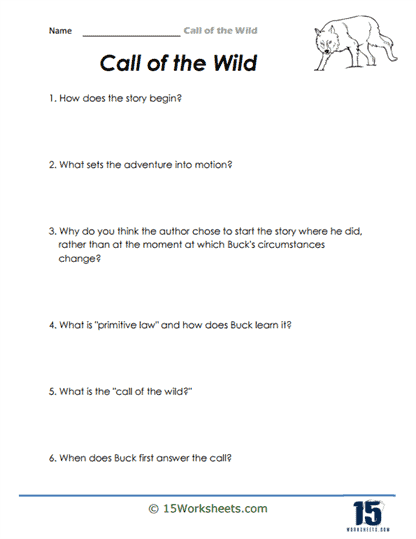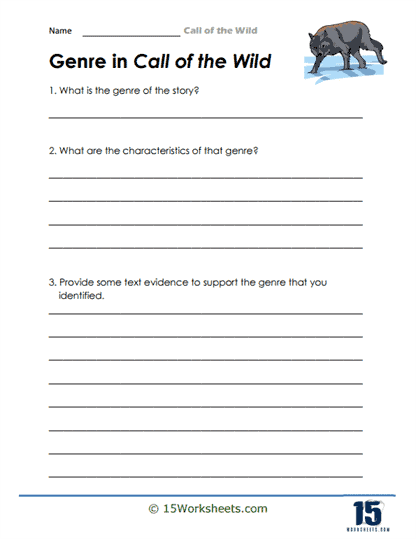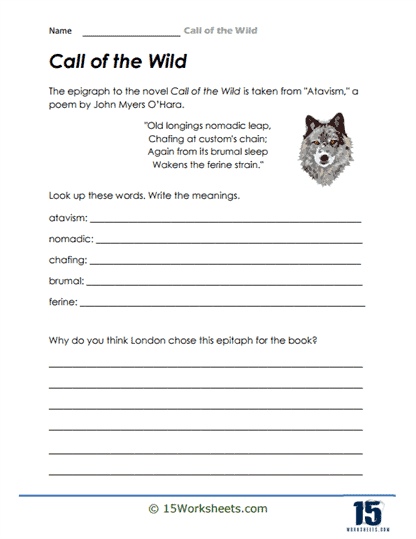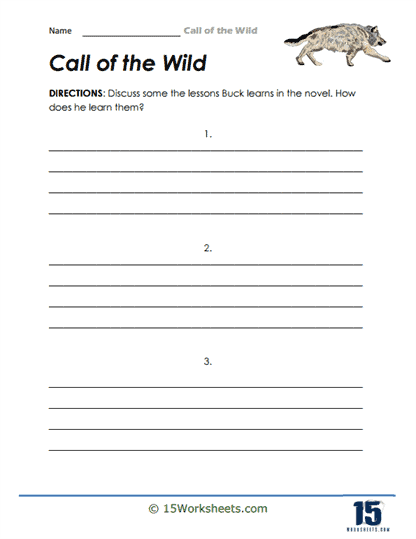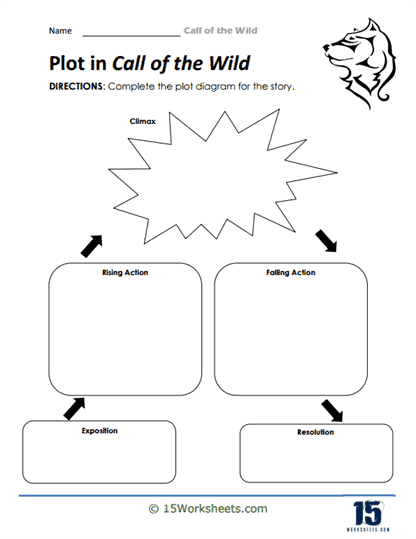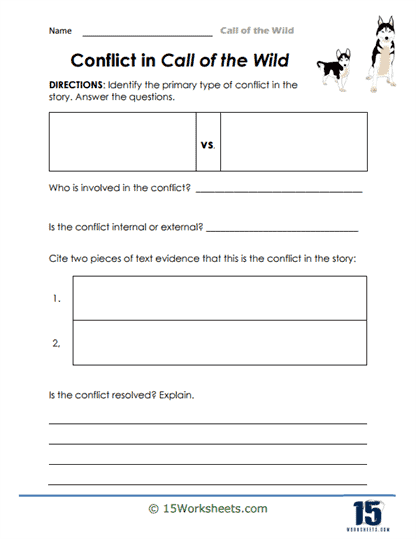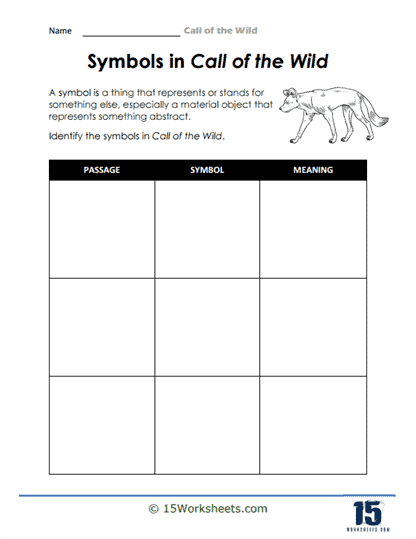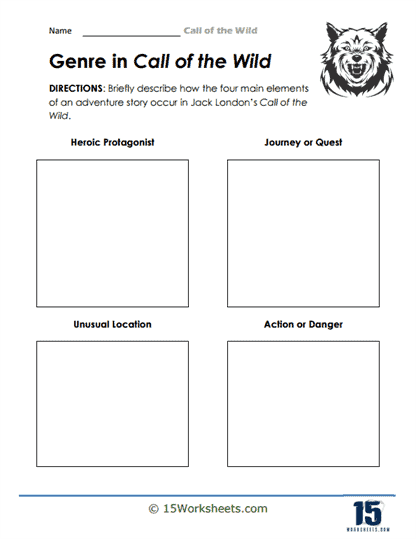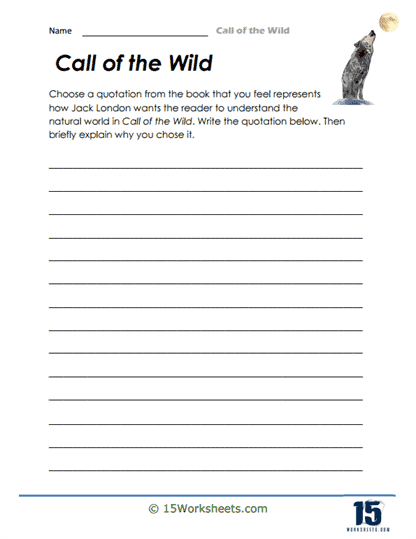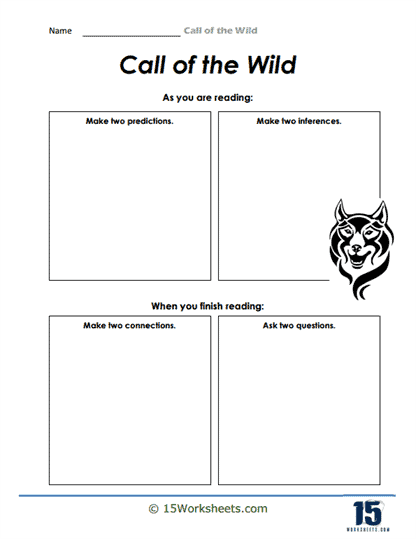Call of the Wild Worksheets
All About These 15 Worksheets
Jack London’s timeless masterpiece, “The Call of the Wild,” has captured the imaginations of readers for over a century. Now, students can embark on an educational adventure with the “Call of the Wild Worksheets Collection.”
This carefully curated resource comprises 15 worksheets, each designed to guide students through the world of Buck, a remarkable dog navigating the rugged landscapes of the Yukon. In this description, we will delve into the significance of studying “The Call of the Wild” and the multitude of benefits it offers to students.
The Importance of “The Call of the Wild”
“The Call of the Wild” is more than a thrilling adventure story; it’s a literary classic that imparts valuable lessons and insights. Here’s why studying this novel is crucial for students:
- Exploration of Nature: The novel immerses readers in the wilderness of the Yukon, fostering an appreciation for the natural world. It allows students to connect with nature’s beauty and challenges.
- Character Development: The journey of the protagonist, Buck, from domesticity to wilderness, offers a profound exploration of character transformation. Students can analyze how experiences shape individuals.
- Historical Context: Set during the Klondike Gold Rush, the novel provides historical context, connecting literature with real events. Students gain insight into a pivotal period in American history.
- Themes of Survival and Resilience: “The Call of the Wild” explores themes of survival, resilience, and adaptation, which resonate with students facing their own challenges and transitions.
- Literary Analysis: Studying the novel allows students to delve into literary analysis, examining elements such as symbolism, imagery, and narrative techniques.
- Empathy and Perspective: The novel’s characters, both human and canine, offer diverse perspectives. Students can step into their shoes, fostering empathy and a broader worldview.
A Brief Synopsis of Call of the Wild
“Call of the Wild,” written by Jack London and published in 1903, is a classic adventure novel set during the Klondike Gold Rush of the 1890s. The story follows Buck, a large and powerful domesticated dog, who is stolen from his comfortable life in California and thrust into the harsh and unforgiving world of the Alaskan wilderness.
Buck is a half St. Bernard, half Scotch Shepherd dog who lives a pampered life on Judge Miller’s estate in Santa Clara Valley, California. However, his life takes a drastic turn when he is kidnapped by a gardener’s assistant and sold to a dog trader. As the demand for sled dogs grows due to the Klondike Gold Rush, Buck is transported to the cold, brutal world of the Alaskan and Canadian wilderness, where he must quickly adapt to survive.
Upon arrival in Alaska, Buck is sold to two French-Canadian mail carriers named François and Perrault. They recognize his strength and intelligence and train him to be a sled dog. Buck learns the harsh realities of his new life, including the importance of obeying the “law of club and fang.” He faces various challenges, such as fighting for food, enduring extreme weather conditions, and navigating the dangerous terrain. As he adjusts to his new environment, Buck develops a fierce rivalry with Spitz, the lead dog on the team.
After a series of violent confrontations, Buck finally defeats Spitz in a vicious fight and takes his place as the leader of the sled dog team. Under Buck’s guidance, the team becomes more efficient and successful, delivering mail and traversing the rugged landscape. François and Perrault recognize Buck’s exceptional abilities, and he earns their admiration and respect.
However, the stability of Buck’s life is once again disrupted when he and the sled dog team are sold to a trio of inexperienced and cruel gold prospectors: Hal, Charles, and Mercedes. These new owners are ill-prepared for the harsh conditions and challenges of the Alaskan wilderness, and their incompetence endangers the entire team. Buck and his fellow sled dogs suffer from overwork, underfeeding, and mistreatment. As the situation worsens, several of the dogs die due to exhaustion, and the sled becomes stuck in thawing ice.
At this critical point, a kind and experienced outdoorsman named John Thornton rescues Buck from the abusive prospectors, cutting him free from his harness just as the ice breaks and the rest of the team is swept away to their deaths. Grateful for his rescue, Buck forms a deep bond with Thornton, demonstrating unwavering loyalty and devotion to his new master. They embark on several adventures together, with Buck saving Thornton’s life on multiple occasions.
As Buck spends more time in the wild with Thornton, he becomes increasingly in tune with his primal instincts and the call of his ancestors. He starts to feel the pull of the wild and occasionally disappears to explore the wilderness, only to return to Thornton out of loyalty. Buck hears the call of the wild growing louder, and he is drawn to a pack of wolves, gradually becoming more comfortable with his wild brethren.
When Buck returns to camp one day, he discovers that Thornton and his friends have been killed by a group of Yeehat Native Americans. Enraged, Buck avenges Thornton’s death by killing several Yeehats before retreating into the wilderness. Having lost his last tie to civilization, Buck decides to fully embrace the call of the wild and join the wolf pack.
“Call of the Wild” is a tale of transformation, as Buck evolves from a pampered pet into a fierce, independent, and wild creature. The story explores themes such as the struggle for survival, the power of instinct, and the enduring bond between humans and animals.
As students engage with Buck’s journey and the novel’s themes, they develop the capacity to analyze narratives, empathize with characters, and connect literature with history and nature. These skills empower them to become not only well-read individuals but also more resilient, empathetic, and reflective thinkers.
Empower your students to journey into the wilderness of literature with confidence, becoming literary adventurers who embrace the call of knowledge and understanding. Invest in their educational journey and their future with the “Call of the Wild Worksheets Collection.” Unlock the doors to literary exploration, one worksheet at a time, and watch as your students become more engaged, enlightened, and empathetic readers and thinkers.


